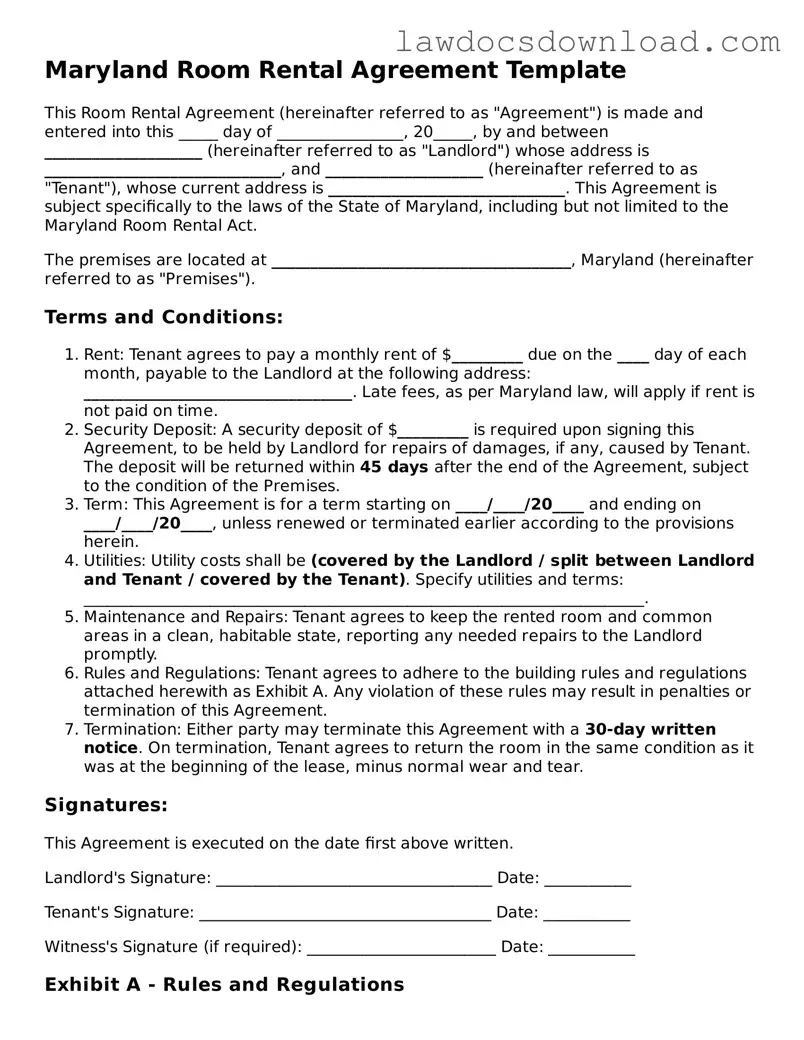The Maryland Room Rental Agreement form shares similarities with the Lease Agreement, primarily in that both establish the terms under which someone may occupy residential property. A Lease Agreement details the relationship between a landlord and a tenant for the rental of an apartment or house, including duration, rent amount, and maintenance responsibilities. This encompasses a broader scope but fundamentally aligns with the room rental agreement’s purpose of defining living arrangements.
Similar to the Maryland Room Rental Agreement, the Sublease Agreement is another document that outlines terms between an original tenant and a new tenant, specifying conditions under which the sub-tenant can rent part or all of the leased property. It mirrors the structure and intent of allocating living space and responsibilities, though it introduces a third party into the contractual relationship between the original landlord and tenant.
The Roommate Agreement is akin to the Maryland Room Rental Agreement, focusing specifically on the arrangement between cohabitants of a shared space. While the room rental agreement lays out the terms between landlord and tenant for a specific room, a roommate agreement delineates the obligations and expectations among roommates, such as chores and utility payments. Both agreements aim to prevent conflicts by clarifying use of shared areas and individual responsibilities.
Similar in nature to the Maryland Room Rental Agreement is the Vacation Rental Agreement, which outlines the terms for a short-term stay, typically in a furnished property. Though the duration and purpose of the stay differ, both agreements specify conditions related to rent, security deposits, and rules of occupancy. This ensures both parties agree on how the property will be used and maintained during the rental period.
The Tenant's Notice to Vacate functions in conjunction with documents like the Maryland Room Rental Agreement by providing a formal mechanism for a tenant to inform their landlord of their intention to leave the rented space. While it typically follows the lifespan of an agreement by concluding the rental period, its existence is predicated on the initial agreement that defined the terms of rent, illustrating another crucial aspect of the tenant-landlord relationship.
Conversely, a Landlord's Notice to Enter is a document that, while different in purpose, interrelates with the principles laid out in a room rental agreement. It gives the landlord the right to access the property for inspections, repairs, or showings, under the conditions previously agreed upon, such as notice period and reasons for entry. This maintains the balance of rights between tenant privacy and landlord property management.
The Security Deposit Receipt Acknowledgment, much like the Maryland Room Rental Agreement, involves the financial transactions between tenant and landlord, focusing specifically on the security deposit. It documents the payment, terms of holding, and conditions for return or deduction at the end of the rental period, ensuring transparency and agreement on financial matters from both parties.
A Property Inspection Checklist complements the room rental agreement by detailing the condition of the rental space at move-in and move-out. This document serves to protect both landlord and tenant by providing a clear record of the property's state, preventing disputes over responsibilities and the condition of the property. It emphasizes the mutual interest in maintaining the rental space's quality.
The Rent Increase Notice can be related to the Maryland Room Rental Agreement in the aspect that it outlines changes to the terms, specifically the amount of rent due, after the initial agreement period has concluded or during it, if allowed. This document ensures tenants are formally informed of adjustments in rental costs, maintaining clear communication on financial expectations.
Last but not least, the Early Termination of Lease Agreement shares a connection with the Maryland Room Rental Agreement as it outlines the conditions under which a tenant or landlord can prematurely end their rental agreement. Although it follows the establishment of the initial agreement, it is inherently tied to the terms set forth regarding duration of stay, penalties, and notice requirements, reflecting the adaptability and potential conclusion of the rental relationship.
